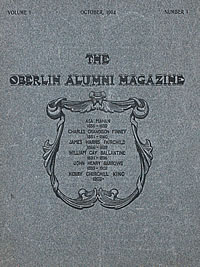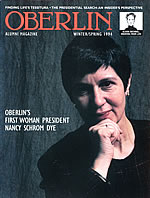 |
 |
 |
||||
 |
|
 |
|
 |
|
Oberlin through the Decades:
October 1914 — A letter from an alumnus (gender undetermined) reads: “I was glad to note that the Oberlin varsity men could not play good enough ball to beat Ohio Wesleyan. It was evidence that Oberlin has not yet gone mad over college athletics.” The writer goes on to praise a discussion that occurred among parents during Commencement week suggesting that male students “have one meal by themselves in the Men’s Building each day, with a view to prevent any of the effeminacy and lightness of conversation with which coeducation is sometimes charged.” October 1924 — An article titled “Better Women” scrutinizes the health and fitness of female students, determining that Oberlin’s physical education requirements—combined with “nine months of strenuous college life”—improve women’s posture and strength. “Yet,” the author notes, “flat-footed and flat-chested maidens, and lassies with fudge plumpness and muddy complexions, damsels stringy and underweight—still abound.” An article praising the newly reorganized Department of Geology and Geography notes that the crystals, minerals, rocks, and instruments used in a new summer field course are in need of a new storage facility—ideally a “good stone structure, dignified and roomy, adapted to the needs of a modern prosperous college.” October 1934 — Political Science Professor Karl Geiser, deemed a controversial campus figure for his pro-Hitler views and admiration of all-things German, pens a piece stating that “90 percent of everything published in America about Germany since the advent of Hitler to power is untrue.” An editorial written by John Brown ’33 summarizes the collective opinions of his graduating classmates on several issues, including war (“a young person’s call to support his country for merely political reasons will arouse his antagonism”) and religion (“the young man of today wants to know if religion really is essential to living”). October 1944 — A recurring feature titled “Oberlin in Uniform” names alumni and students serving in the armed services, along with those reported killed, missing in action, or as prisoners of war. A photograph of the new physics laboratory is accompanied by a caption indicating that “another unit in the new Science Quadrangle, the biology laboratory, will be built after the war.” Oberlin’s Annual Fund reaches an all-time high of $40,547. October 1954 — A letter to the editor applauds the summer traveling troupe of the Gilbert and Sullivan Players. “The troupe is attracting full houses every night all over Cape Cod. Is there not some way they could be sent on tour as an example of what Oberlin students do? An evening with them would prove to be more eloquent and persuasive than many a speech before prospective students.” October 1964 — OAM runs a four-page photo montage of the Oberlin Choir’s two-month trip to the Soviet Union, comprising 35 performances in Leningrad, Moscow, and Chernovsti. The student body reacts heatedly to the abolishment of the Saturday Night Calling Hours—an experiment in which women were permitted weekly evening visits to men’s dorm rooms. “The rejection of calling hours impresses us with the near-impossibility of obtaining social change on the campus and the lack of contact the faculty has with themoods and mores of the students,” reads a quote from a student. October 1974 — The opening of Mudd Learning Center requires the boxing and moving of 10 miles of books from Carnegie Library. To speed the transfer, student workers construct stairway ramps on which to slide the heavy boxes. Opposition to Oberlin’s segregated dorms and clubs is countered by an Asian student asking, “What is it we fear when people of color who find themselves with a common American experience desire to live together? Oberlin will only help its minority students when it realizes that all persons in all societies need support groups.”
Fall 1994 — Following two months as Oberlin’s newest president, Nancy Schrom Dye shares her initial impressions and early plans. “I came to Oberlin because I know of no other college or university anywhere with more interesting or capable students, a more outstanding faculty in the arts and sciences and in music, or a richer or more distinctive history.” OAM features five Oberlin students from South Africa who cast absentee ballots for South Africa’s first multiracial election. Next Page >> |
 October 1904 — The inaugural issue opens with news that 1897 alumna Florence May Fitch will enter upon her new duties as dean of women. Ms. Fitch’s young age (which editors respectfully do not disclose) deems her appointment particularly stunning, but readers are assured that her “days of study are so little distance behind her that she is sure to keep a sympathetic knowledge of student life and needs.” The magazine announces that funds for Finney Memorial Chapel have been provided by F. Norton Finney, allowing construction of the building to commence shortly.
October 1904 — The inaugural issue opens with news that 1897 alumna Florence May Fitch will enter upon her new duties as dean of women. Ms. Fitch’s young age (which editors respectfully do not disclose) deems her appointment particularly stunning, but readers are assured that her “days of study are so little distance behind her that she is sure to keep a sympathetic knowledge of student life and needs.” The magazine announces that funds for Finney Memorial Chapel have been provided by F. Norton Finney, allowing construction of the building to commence shortly.  Fall 1984 — A special issue devoted to the Report of the President highlights Oberlin’s accomplishments under the
one-year tenure of President Fred Starr, marked especially by gains in student recruitment, increased alumni participation
in the Annual Fund, and broadened public awareness of Oberlin’s strengths. The year’s academic accomplishments, notes Starr, include ever-growing resources in computing, a new series of colloquia designed specifically for freshmen, a requirement that students demonstrate expository writing skills, and the broadening of Conservatory courses in jazz and non-Western music.
Fall 1984 — A special issue devoted to the Report of the President highlights Oberlin’s accomplishments under the
one-year tenure of President Fred Starr, marked especially by gains in student recruitment, increased alumni participation
in the Annual Fund, and broadened public awareness of Oberlin’s strengths. The year’s academic accomplishments, notes Starr, include ever-growing resources in computing, a new series of colloquia designed specifically for freshmen, a requirement that students demonstrate expository writing skills, and the broadening of Conservatory courses in jazz and non-Western music.